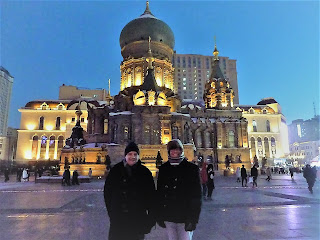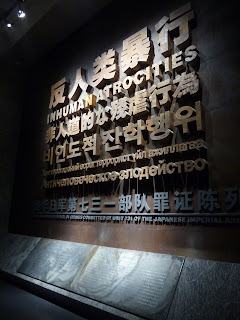Garry and I discovered that there's more to Harbin than just buildings of snow and ice. The city is relatively young compared with many other places in China. It was founded in 1898 after the arrival of the Chinese Eastern Railway. It initially prospered as a region increasingly dominated by immigrants from the Russian Empire including people fleeing the hardships of Tsarist Russia and later the Bolshevik revolution.
As a result, Russian influenced architecture can be found all over the city. Perhaps the most prominent of these landmarks is St Sophia Cathedral. This is a classic onion-dome topped Russian orthodox church in the centre of town. However, it's no longer a place of worship. Today the nave houses a photographic exhibition of early Harbin.
Incredibly, a dramatic painting of the last supper still hangs over the altar's original location. Outside, locals sell satay sticks of frozen, toffee coated fruits from bicycle carts. Garry and I had seen these everywhere the previous day at the Ice and Snow Festival. We decided we had to try one before we left Harbin. The fruit is certainly refreshing and of course, it stays permanently frozen in the city's bitterly cold sub-zero temperatures.
We also visited the city's Siberian Tiger Park. It runs a very successful breeding program. Today several hundred tigers live in the park many of which are eventually released back into the wild. The park offers two viewing experiences. The first is slow bus ride through the park's many open range enclosures. This gives visitors an opportunity to see these magnificent creatures up close.
Garry and I were astonished by the number of cats we saw strolling, sitting and sunning themselves. The park separates males, females and different age groups otherwise chaos ensues. The animals all appeared to be healthy and well-fed. Just how well fed soon became apparent.
Halfway through our safari the bus driver stopped the tour and began soliciting money from the passengers. We eventually worked out that he'd offered to bring some live chickens into the enclosure if we all forked out enough money. Before we knew it a jeep had pulled up and two live chickens were tossed from the window. Sure enough, the tigers came running, chased the poor birds and eventually devoured them. Only in China!
The second viewing opportunity involved a series of mesh enclosed gangways that took visitors on a walking tour through a series of smaller enclosures. Once again feeding experiences were on offer. However, this time we were offered chunks of steak that you then fed through the mesh using long BBQ tongs. We couldn't resist and can now say we've hand fed "wild" tigers.
Our private guide then took us down to the shores of the Songhua River. We were amazed to discover the equivalent of the local "Easter Show" unfolding on the frozen river. Thousands of people were enjoying all manner of ice and snow-oriented activities set up either side of a temporary boulevard that stretched across the river. I can honestly say we saw ice activities we've never witnessed in our lives. We eventually negotiated the hire of dune buggy and headed out for a wild ride along the frozen river.
Perhaps the most fascinating venue we visited was the 731 Unit Museum in the south of the city. It contains a poignant exhibit documenting the sinister deeds of what was once the world's largest biological warfare research facility. The Japanese created this facility after invading Manchuria in 1937. At its peak, it was a 50-building complex covering 6 sq km. It even had its own railway station and a small airfield. We were horrified to learn that thousands of imprisoned locals and POWs were experimented on resulting in the death of at least 600 people annually for almost a decade.







































